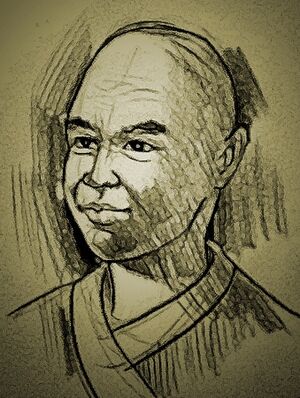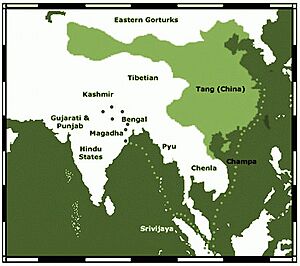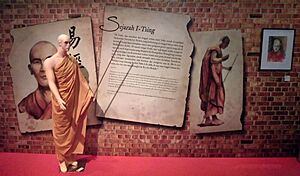Yijing (monk) facts for kids
Quick facts for kids
Yijing
|
|
|---|---|

Artist impression of Yijing
|
|
| Born | 635 CE Fanyang (Yanjing), Tang Empire
|
| Died | 713 CE |
| Occupation | Buddhist monk, traveler |
| Religion | Buddhism |
| Religious career | |
| Teacher | Shi Huen |
| Yijing | |||||||||
|---|---|---|---|---|---|---|---|---|---|

Excerpt of a scroll from Yijing's Buddhist Monastic Traditions of Southern Asia. Tenri, Nara, Japan
|
|||||||||
| Traditional Chinese | 義淨 | ||||||||
| Simplified Chinese | 义净 | ||||||||
|
|||||||||
| Buddhist title | |||||||||
| Traditional Chinese | 三藏法師義淨 | ||||||||
| Simplified Chinese | 三藏法师义净 | ||||||||
| Literal meaning | Tripitaka Dharma-Master Yijing | ||||||||
|
|||||||||
| Zhang Wenming | |||||||||
| Traditional Chinese | 張文明 | ||||||||
| Simplified Chinese | 张文明 | ||||||||
|
|||||||||
Yijing (635–713 CE) was a famous Chinese Buddhist monk. He was also known as I-ching or I-tsing. His birth name was Zhang Wenming. Yijing lived during the Tang dynasty. He was famous for his travels and for translating many important Buddhist texts.
His travel stories are a key source of information. They tell us about the old kingdoms along the sea route between China and India. He wrote a lot about Srivijaya in Indonesia. Yijing studied at the Buddhist university of Nālandā in India. He helped translate many Buddhist writings from Sanskrit and Pali into Chinese.
Contents
Yijing's Amazing Journey
Starting His Adventure
Yijing was born Zhang Wenming. He became a monk when he was 14 years old. He really looked up to Faxian, another famous monk who traveled to India much earlier.
A kind person named Fong helped Yijing with money. This allowed him to visit the famous Buddhist university of Nālandā in Bihar, India. He wanted to study Buddhism even more deeply there.
Travels to Srivijaya and India
Yijing left Guangzhou by boat. After 22 days, he arrived in Srivijaya. This place is now called Palembang in Sumatra. He stayed there for six months. During this time, he learned Sanskrit grammar and the Malay language. He also wrote about visiting other places like Malayu and Kiteh (Kedah).
In 673, after ten more days of travel, he reached the southwest of Shu. Yijing wrote about the "Kunlun peoples," an old Chinese name for Malay people. He described them as having "curly hair, dark bodies, bare feet and wear sarongs."
He then arrived on the east coast of India. There, he met an older monk and stayed for a year to study more Sanskrit. Later, they traveled with a group of merchants. They visited 30 other small kingdoms. On the way to Nālandā, Yijing became sick and could not walk. He was left behind by the group but eventually made it to Nālandā. He stayed there for 11 years.
Returning to Srivijaya
In 687, Yijing stopped in Srivijaya again on his way back to China. At that time, Palembang was an important center for Buddhism. Many foreign scholars gathered there. Yijing stayed for two years. He worked on translating original Sanskrit Buddhist scriptures into Chinese.
In 689, he went back to Guangzhou just to get ink and paper. Srivijaya did not have these supplies then. He returned to Srivijaya the same year to continue his work.
Finally Back Home in China
By 695, Yijing had finished all his translation work. He finally returned to China, arriving in Luoyang. Empress Wu Zetian gave him a grand welcome. His entire journey had lasted 25 years. He brought back about 400 Buddhist texts that he had translated into Chinese.
Yijing wrote two important travel diaries. They are called A Record of Buddhist Practices Sent Home from the Southern Sea and Buddhist Monk's Pilgrimage of the Tang Dynasty. These books describe his exciting journey to Srivijaya and India. They also tell us about life in India and the customs of different local people.
Buddhist Traditions Yijing Saw
Yijing wrote that in most parts of India, people followed both "vehicles" of Buddhism. Some Buddhists practiced according to the Hinayana teachings, and others followed Mahayana teachings. He said that northern India and most of the islands in the South Seas (like Sumatra and Java) mainly followed "Hīnayāna." But in China and Malayu, Buddhists mostly followed Mahāyāna.
Yijing also wrote about how different Buddhist groups were connected in India. He said, "There are many different schools in the West, but only four main schools have a continuous tradition." These schools were the Mahāsāṃghika, Sthavira, Mulasarvastivada, and Saṃmitīya nikāyas. He explained that it was not clear which of these schools belonged to Mahāyāna or Hīnayāna. This means that a monk's group did not always decide if they learned "Hīnayāna" or "Mahāyāna" teachings.
Buddhism in Srivijaya
Yijing greatly admired the high level of Buddhist learning in Srivijaya (which is modern-day Sumatra). He even suggested that Chinese monks should study there before traveling to Nalanda in India.
In the fortified city of Bhoga, Buddhist priests number more than 1,000. Their minds are focused on learning and good practice. They study all subjects just like in India. The rules and ceremonies are exactly the same. If a Chinese priest wants to go West to read the original scriptures, he should stay here for one or two years and practice the proper rules....
Yijing's visits to Srivijaya allowed him to meet people from other nearby islands. He wrote that the Javanese kingdom of Ho-ling (Kalingga Kingdom) was east of Bhoga. It was about a four or five-day sea journey away. He also noted that Buddhism was thriving across the islands of Southeast Asia. He said, "Many kings and leaders in the islands of the Southern Sea admire and believe in Buddhism. Their hearts are set on doing good deeds."
Texts Yijing Translated
Yijing translated over 60 texts into Chinese. Some of his important translations include:
- Mūlasarvāstivāda Vinaya (一切有部毗奈耶)
- Golden Light Sutra (金光明最勝王經) in 703
- Diamond Sutra (能斷金剛般若波羅蜜多經, T. 239) in 703
- Sūtra of the Original Vows of the Medicine Buddha of Lapis Lazuli Radiance and the Seven Past Buddhas (藥師琉璃光七佛本願功德經, T. 451), in 707
- Avadanas (譬喻經) in 710
See also
 In Spanish: Yi Ching (monje) para niños
In Spanish: Yi Ching (monje) para niños
- Faxian
- Chinese Buddhism
- A Record of Buddhist Practices Sent Home from the Southern Sea
- Song Yun
- Xuanzang
- Vikramashila
- Hyecho
- Great Tang Records on the Western Regions
- Wang ocheonchukguk jeon



